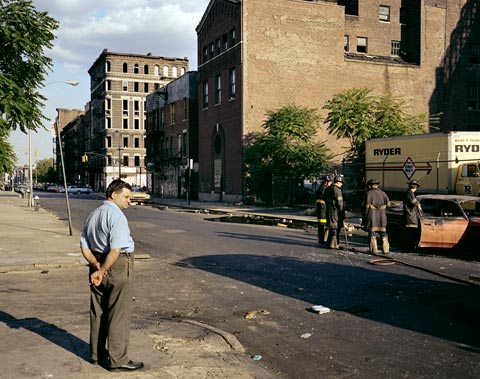
East 1st Street, The Bowery and Second Avenue, 1980 (4×5 film)
In the post below I ranted a little about the supposed death of photography (Is Photography Dead/Newsweek) caused, in part, by Photoshop, a program so amazing that one no longer needs the temporal world to make images. Anyway, back in 1980 when photography was, presumably, still alive I began making pictures of the Lower East Side in collaboration with Ed Fausty using a 4×5 view camera. You can click on the link at the top right to see the whole thing.
We were doing the project by the skin of our teeth financially, and rarely checked exposures with expensive Polaroids. So, some of the negatives are a little thin (underexposed), making them difficult to print. And some of them were not developed properly, and have problematic color shifts. The picture above was one of those, both thin and color shifted. Add to that the degradation of the film over the years, due to the instability of the materials from of that era, and you have a near impossible situation.
But thanks to Photoshop it is possible to coax the color back and largely correct the color imbalances–bring dead pictures back to life, as it were. It’s not a pushbutton process, however, takes a lot of time, and requires a good deal of experience with the many different ways to select areas, colors, and densities. The end result, in this case, is an image never printed before, that comes alive in the present.
The Lower East Side project spans 28 years of time, and is about looking back, reinterpreting, and looking again in the present. In that sense the work is not primarily about static visual documents, but rather a process that takes into account the actions of time and change. Understanding the notion, that images of the “real world” are constantly acted upon by the shifting sands of culture, opinion, and history, is critical to working with these factoids called photographs. Nevertheless, one does not necessarily give up on the enterprise of “taking pictures” because their veracity can be questioned.
Peter Plagens in his Newsweek article refers at one point to “photography’s tango with the truth.” I think that’s an apt description, and it encapsulates the power of photography not its weakness. As a photographer I may play the part of Joe Friday in search of hard evidence. “Just the facts, ma’am.” But it’s the tango with the truth that holds our interest and keeps the game alive.